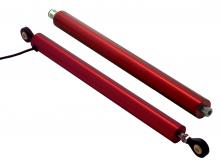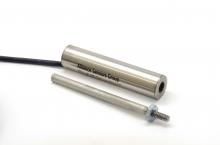Blog
To understand what a linear position sensor is, consider that a "sensor" is an electromechanical device that measures a physical parameter such as position, temperature, pressure, or flow and provides an output in some electronic format. This output may be a proportional analog signal such as a dc voltage or current, or a digital signal that is connected to a digital display or sent over a network to be interpreted by a computer or PLC. In some cases it may be merely a state change; in effect, it is an "on" or "off" switching signal sent to a control system computer.
"Position" implies measuring the location of an object that is movable in relation to some other point or object. Thus, an example of position can be the dimension of a manufactured part, the extension of a hydraulic actuator, the location of a cutting tool on a machine, or the opening of a steam valve in a power plant based on the position of the valve stem relative to the valve body.
The "linear" part of the description means measuring the distance in a straight line or in a single axis to a point or surface or object in relation to some reference point, as opposed to the angular motion of a rotating shaft.
There are at least a dozen technologies for measuring linear position, some without any actual contact with the object being observed and others that require some movable element to be in physical contact with the object. An example of the former is proximity sensors that indicate whether an object or target is nearby or not by a state change, which is more like a qualitative measurement. However, a very large number of linear position sensors provide a quantitative, proportional electrical output, and a majority of them require physical contact with the object.
But another variable in a linear position measurement is that it can be incremental in relation to some "home" position, or absolute as a stand-alone measurement. Thus, the nature of linear position measurement is typically a function of the sensor's underlying technology. This often affects the choice of the sensor to be employed for any particular linear position measurement.
Lots of sensor technologies are based on changes in the device's electrical properties such as inductance, resistance, capacitance, magnetic fields, or resonant frequency due to a movable element like a rod or shaft. Several of the non-contacting sensors rely on measuring the time for a wave to be directed toward the object being measured and then reflected back to the source.
Most sensing technologies for linear position measurement have several important technical attributes that need to be studied in choosing the optimum sensor for any particular measurement application, including:
![]() Range: What is the range of motion or position measurement for which the sensor is optimized?
Range: What is the range of motion or position measurement for which the sensor is optimized?
![]() Accuracy: What is the required precision and confidence level in the measurement?
Accuracy: What is the required precision and confidence level in the measurement?
![]() Resolution: What is the smallest change in position input that the sensor can measure?
Resolution: What is the smallest change in position input that the sensor can measure?
![]() Environment: Under what temperature, vibration, shock, EMI fields, etc. will the sensor operate.
Environment: Under what temperature, vibration, shock, EMI fields, etc. will the sensor operate.
![]() Reliability/Life: What is the projected life of the sensor and how often must it be recalibrated or replaced?
Reliability/Life: What is the projected life of the sensor and how often must it be recalibrated or replaced?
![]() Installed Costs: Which includes purchase price but also setup, calibration, operator training, spares, etc.
Installed Costs: Which includes purchase price but also setup, calibration, operator training, spares, etc.
In terms of sensor range, the measurement may be for a change in position of what may be called a "macro" position measurement, typically covering from several inches or centimeters up to many feet or meters, or it may be for small motions, often known as "micro" position measurements, usually for low fractions of an inch or millimeters. Examples of the latter would be strain measurement in materials under load, the position of a valve spool for feedback stabilization of a fluid power system, or the expansion or contraction of a mechanical part with ambient temperature change. For an example of a macro position measurement, consider the fairly precise spacing between the rails on a railroad track bed, or the spacing between vehicles in a self-driving car.
Clearly, a sensor with the ability to measure position or dimensional changes down to a few thousandths of an inch is not needed for the vehicle spacing or rail gaging. So the issues of resolution and accuracy are not as high a priority as reliability and environmental robustness for such a sensor application. On the other hand, the superior resolution and high accuracy of the sensor would be very important for instruments making quality assurance measurements in a manufacturing plant for checking parts or controlling machines, particularly in places where the environment can be more readily controlled as well.
These examples illustrate the various technical features and specifications which are lumped into the category of sensor performance parameters that need to be considered when choosing the proper sensor technology for position measurements. These parameters need to be balanced against the application's economic issues, which are wrapped up in the installed costs. This is a very individualized consideration for any application and the balancing is often referred to as evaluating the price-to-performance ratio of the proposed sensing system for the required position measurement. The process can be made somewhat easier by identifying those top-tier requirements that have the highest priority and focusing more attention on them to avoid being distracted or overwhelmed by lower priority issues.
This treatise is provided to assist potential linear position sensor users or specifiers in getting an overall look at the field of position sensing and the technologies available and ultimately helping them to better understand the issues involved in making a sensor choice. Also, experienced applications engineers employed by potential suppliers can offer considerable help as well, so it pays to inquire about a prospective supplier's support staff.
We have real world experience and know how to solve your measurement challenges. Need technical help with your measurement application? Call us today 856-727-0250 or send us a message by clicking here.
Related Blogs
What is a LVIT…




